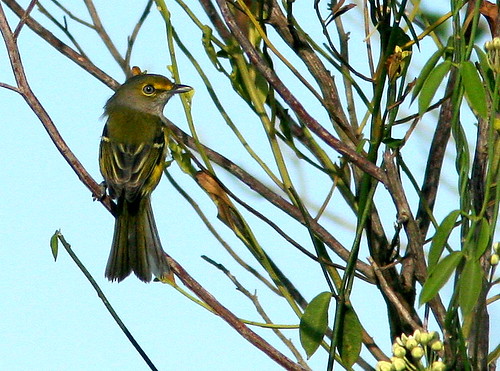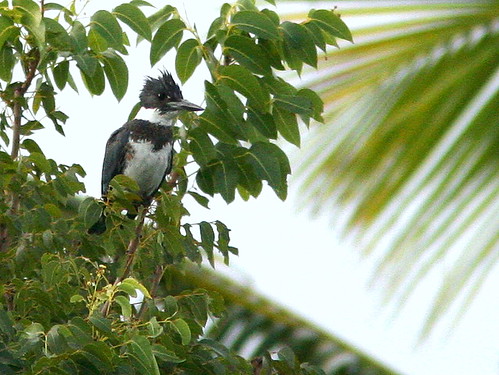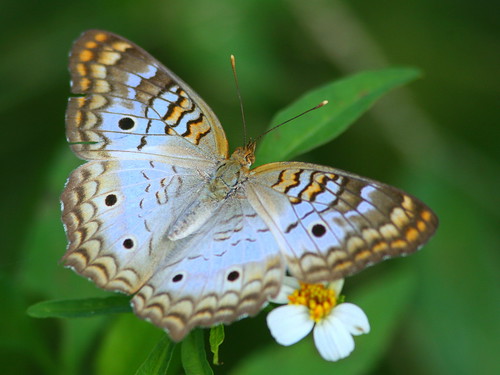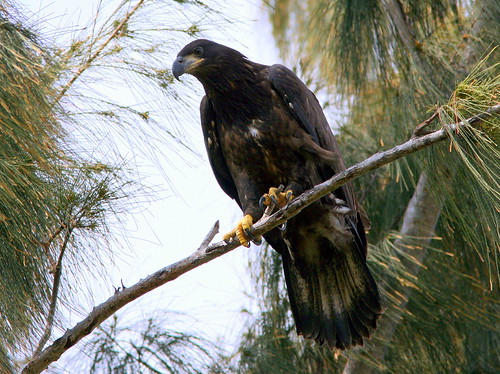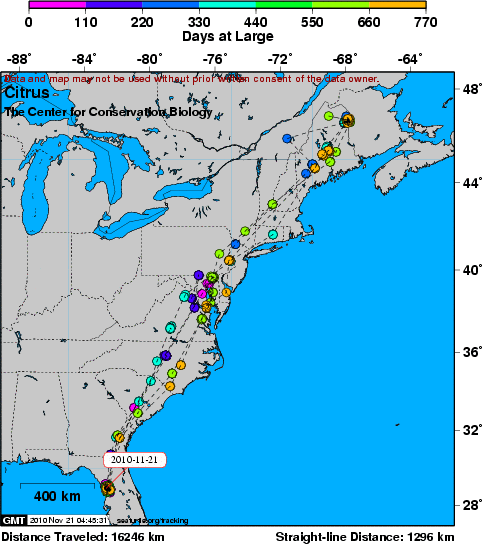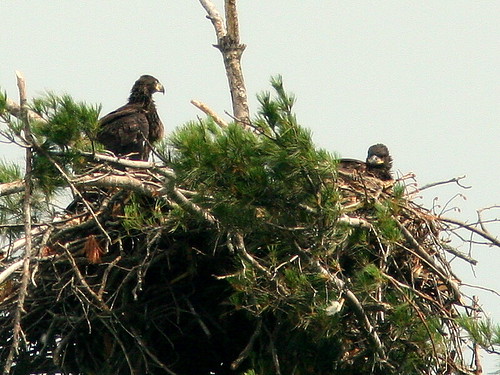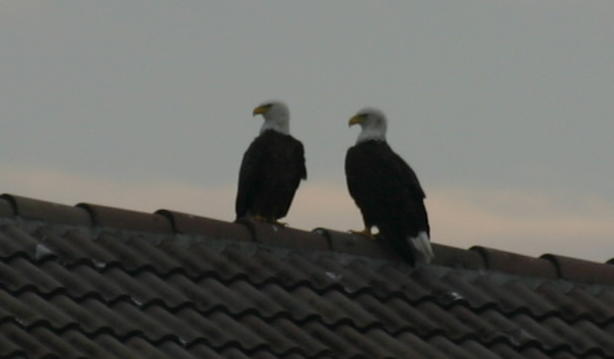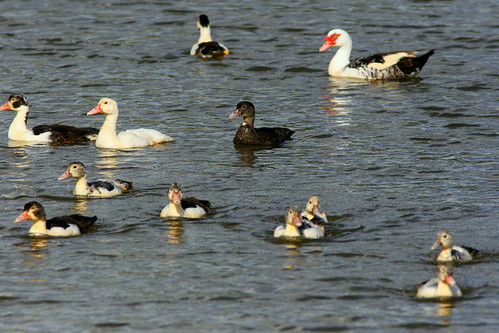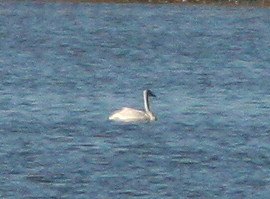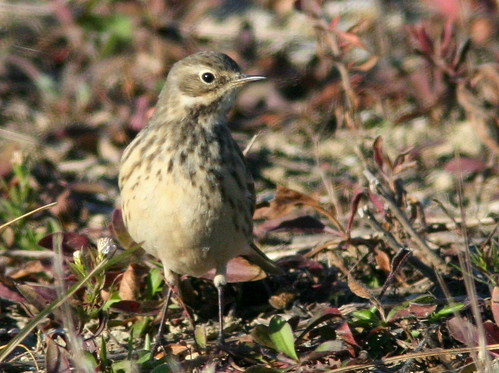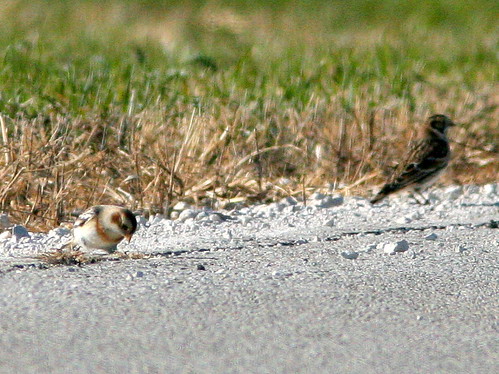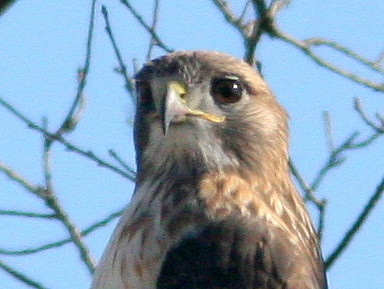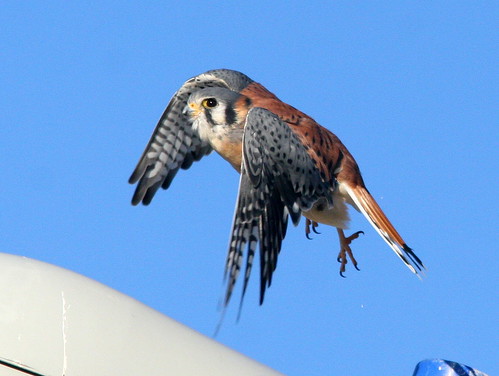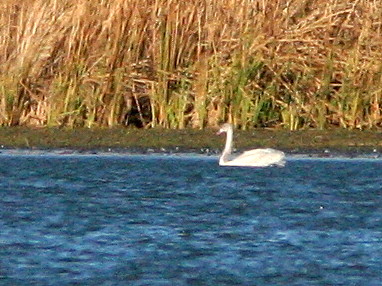Posted by: Ken @ 12:28 pm
A bad cold has limited my time afield the past week. Feeling the need to attain Bird Chaser’s “Recommended Daily Allowance” (RDA) of 20 bird species, I ventured out on a 15 minute walk to the canal that borders our subdivision, and also serves as the eastern edge of the Broward Water Conservation Area. The WCA is a buffer area between the developed west edge of Broward County and the Everglades. I call the southeastern corner of the WCA the “West Miramar Environmentally Sensitive Land (ESL)“:
As I walked in on the gravel road, House Wrens and Common Yellowthroats scolded from the weeds on either side. Boat-tailed and Common Grackles flew overhead, Blue Jays called to each other in the dooryards, and doves cooed from rooftops: White-winged, Mourning and Eurasian Collard-Doves. Palm and Yellow-rumped warblers flitted in the Live Oaks and hedges. Ten species already. For an hour and a half, I remained within a small area of disturbed grassland and woodland along the canal, allowing the birds to come to me.
A male Northern Flicker sits atop the broken-off trunk of a dead Royal Palm:
Suddenly, a male American Kestrel displaces the flicker:
The kestrel flies to the top shoot of a distant live palm– he appears to be choking to death!
After several seconds of gagging, he dislodges a pellet, comprised of indigestible prey remains: feathers, hair, nails, insect exoskeletons and some bones: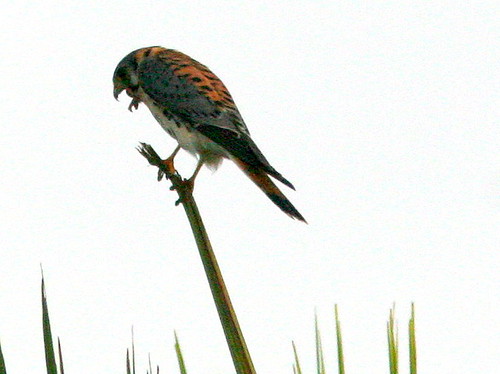
There is no need to wander far and wide to enjoy little pockets of wild space. Resident White-eyed Vireos have now been joined by a larger number of migrant White-eyes from points north: 
A Loggerhead Shrike is unusually tolerant of my close approach:
A flock of Cattle Egrets is joined by an immature White Ibis (dark wings) and a Snowy Egret (yellow feet):
A Male Belted Kingfisher stands watch over the canal next to our property:
He flies high over the water, hovers and then makes a steep dive: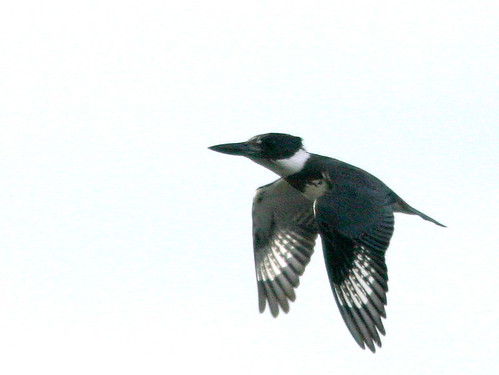
The kingfisher catches a good-sized fish, takes it to a perch, subdues it by striking it against the branch several times, flips it and swallows it headfirst (click on the image to see sequence of photos):

On the opposite shore of the canal, a Great Blue Heron imitates a ballet dancer as it makes a graceful landing: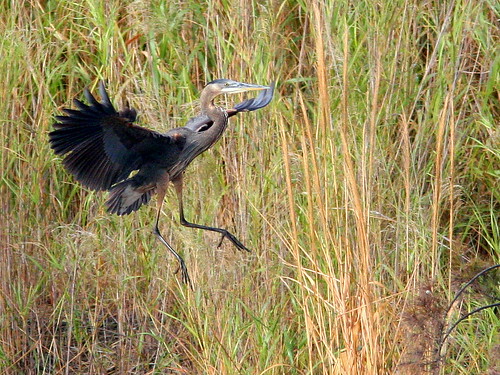
How can I pass up another Northern Cardinal photo-op, especially since it is the twentieth species for the day?:
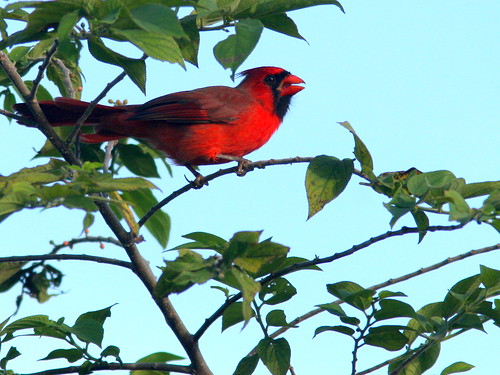
Having attained my “RDA”, I looked up and almost ignored what I first thought was a female cardinal. On closer inspection the large bill belongs to a migrating female Summer Tanager:

In an adjacent exotic Melaleuca tree, a strongly marked male Prairie Warbler eyes me– 22 species!:
Suddenly two Northern Harriers appeared in the distance over the wetlands. Characteristically, they reached the near margin and turned around. Anticipating that they might continue to move back and forth, I positioned myself at a clear place on the levee, to get a better look should they reappear. Soon they came back into view. One was a large brown female, but the other was a smaller adult male. I have found males to be relatively scarce, and I have never obtained a decent photo of one. They were about 100 yards away when they turned and flew from my left to right side.
The male Northern Harrier is beautifully patterned in gray, black and white:
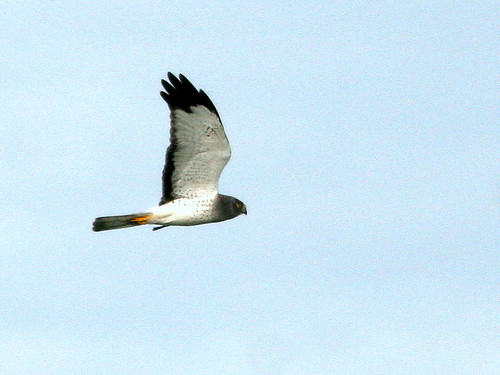
As my 23rd species moves away, he displays his signature white rump: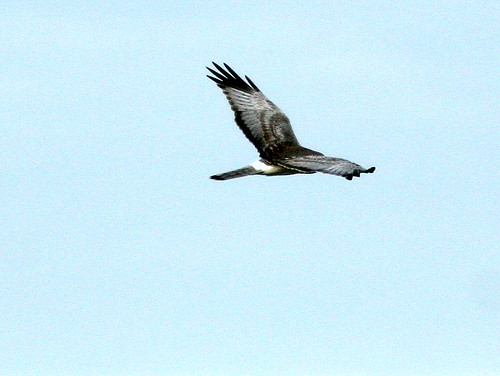
Turning my attention to the butterflies, I capture my first-ever image of a Giant Swallowtail:
Another first– a Long-tailed Skipper, with an iridescent blue-green body: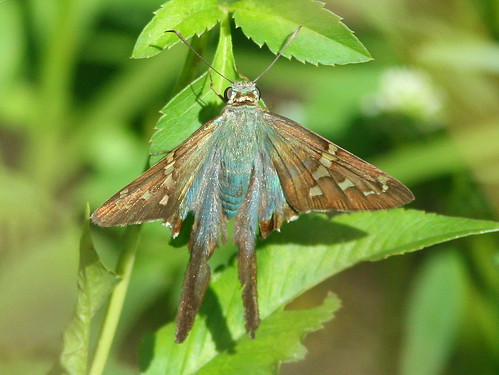
This
White Peacock rests in the cool shade. It is a particularly fine
specimen, as most have wings that are tattered by their frequent
territorial skirmishes::
A Zebra Heliconian, State Butterfly of Florida:
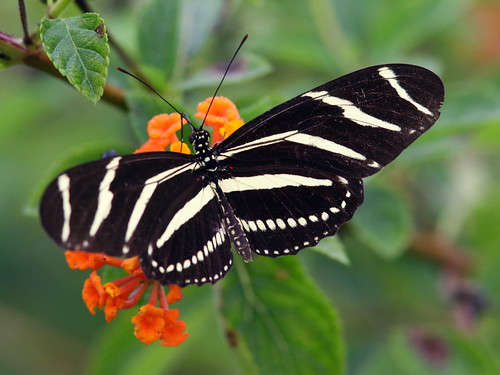
Nearby, a male Julia Heliconian:
The Scarlet Skimmer (Crocothemis servilia) is a dragonfly species native to Asia which was introduced to southern Florida. It was first discovered in the U.S. near Miami, Florida, in 1975 and since has become common across most of the southern half of the Florida peninsula:
Proud Grandfather talk–
Before I leave the subject of butterflies, I want to share a few photos our daughter just sent us from Illinois. While we were back there about 6 weeks ago, our 6 year old granddaughter found a Black Swallowtail caterpillar on the sidewalk in front of their home. The budding naturalist proudly brought it to me and announced she was going to save it and watch it turn into a butterfly.
She did this the first time when only three years old. Here is a 2007 photo of the girls with an emerging Black Swallowtail. Read the full story : Goodbye, Butterfly)
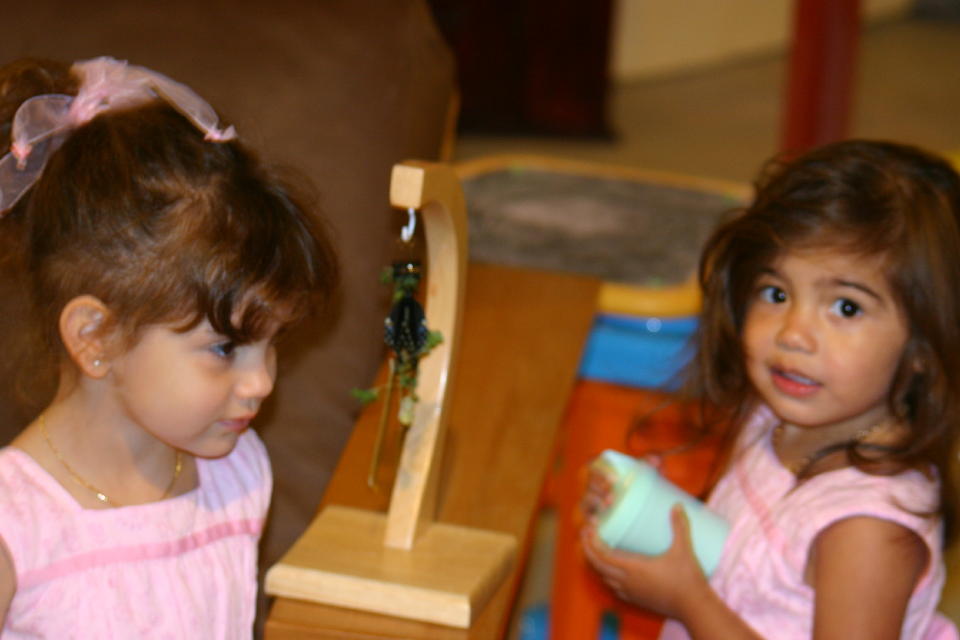
She already knew that this species eats parsley and other plants in the carrot family, so she found some Queen Anne’s lace stalks and put them into a plastic storage container with the caterpillar. In only about three days, the caterpillar lost its skin and turned into a chrysalis. She asked if I knew how long it would be before the butterfly emerged. I told her that this late in the season they normally would not come out until the next spring, but if kept inside the house it could be sooner.
This past week, the butterfly emerged as she and her 5 year old sister watched:
She fed it sugar water, took it to school where she demonstrated it in
both of their classrooms, and allowed it to fly free inside the house.
She wanted to turn it loose outdoors, as some can survive the winter if they can find shelter. Since they went “south” (only about 80 miles) to Starved Rock this
past weekend, she brought it there and released it. It flew a short distance and then did not move much because of the cold. When she returned
later, she found it on the ground, lifeless. She was very sanguine about
this, saying she wants to try this again next spring.
On Thanksgiving Day, the girls visited the Shedd Aquarium in Chicago, where they participated in a children’s program:
Also see:
Birders Start Young
Early Birder
Posted by: Ken @ 1:15 pm
An adult Bald Eagle soars over the nest near our Florida home: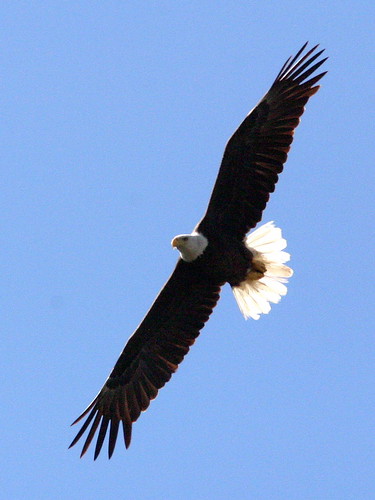
Those of us who have been watching our local pair of Bald Eagles and their progeny for the past three breeding seasons are well aware that our Florida eagles are “contrarians” when it comes to migration. While nearly all other migratory birds head south after nesting and rearing their young, our local eagles do just the opposite– they turn north.
Well, this is not exactly the case, as Florida’s adult Bald Eagles, especially those from the southernmost end of the peninsula, don’t exhibit as much wanderlust during the non-breeding season. Generally, the adults tend to move about locally, or at most, regionally in the lower third of the Sunshine State, while younger (1-4 year old) birds often become long-distance travelers.
Our local pair in Pembroke Pines is now fixing up the nest they have used for at least three previous seasons. In this photo from last December, repair of the nest is about complete. On December 18th the first of three eggs would be laid. They appear to be following the same schedule this year, although now, vegetation has grown up in front of the nest making it almost impossible to see or photograph..
On December 6, 2009, the female inspected the nest after bringing in a stick: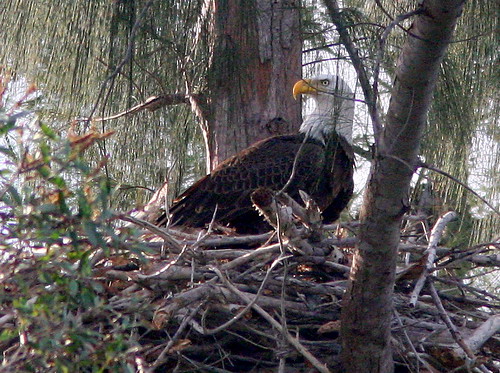
A year earlier, I photographed “Hope,” the larger of the two eaglets that hatched in 2009,at 13 weeks of age, one month before she became independent and migrated, not southward, but to the north:
Thanks to satellite radio tracking, we know that younger Bald Eagles from Florida counter the prevailing trend by turning north in late June and July. Those that follow the Atlantic coast commonly end up at or near Chesapeake Bay, to be joined later by others of their species from more northern climes. Some young eagles may fly as far north as New England and Canada.
Movements of “Citrus,” a male Bald Eagle from Florida (click on map for animated display):
The above map, displayed on seaturtle.org, is from the Satellite Tracking Project of The Center for Conservation Biology, “Bald and Golden Eagles of the Chesapeake Bay,” It tracks the movements of “Cirtus,” a male eagle from Florida that was fitted with a transmitter in October, 2008 in the Chesapeake Bay area of Maryland. Click on the image to see a dramatic fully animated map that shows the entire record of Citrus’s travels. He has twice spent late summer and fall up near the border between Maine and Canada, and now, once again, has settled down on Florida’s Gulf Coast.
This past spring, up at our Illinois “summer” home, a pair of Bald Eagles set up housekeeping only a mile and a half from our condo. They were the first pair known to nest in Kane County since DDT was banned in the early 1979s, an interesting parallel to our Florida eagles, which gained notoriety by establishing the first active nest in Broward County. The Illinois eagles began breeding about four months later than their Florida counterparts.They probably laid their eggs in mid-March, after the oldest of the three Florida eaglets had already fledged.
On May 1 of this year, the Illinois eagles were tending chicks that were only one or two weeks old– too small to be seen over the rim of the nest:
By early June, 2010, the two Illinois eaglets were fully feathered, although it would be a month before they took their first flight. They probably migrated south in late August or September:
Mary Lou and I, as “migrants” between Florida and Illinois, assumed we understood the rationale for the deviant behavior of the Florida eagles. Our Pembroke Pines eaglets hatched out in late December and January, just about the nicest time for them (and us) to enjoy life in South Florida. By then, hurricanes are but a memory, rainstorms are few, and bugs are less troublesome. Fish and long-legged wading birds, both important prey species for eagles, are concentrated in smaller pools of receding water. Parent eagles have no trouble finding food for their hungry and fast-growing broods. Who can blame the youngsters for getting out of the heat and incessant blackbird and mockingbird attacks, and for staying away until October or November, when the nights turn cool and the storms abate?
Likewise, since the diet of Bald Eagles consists primarily of fish, we assumed that the northern-breeding birds must move south to find open water as the lakes freeze up. As it turns out, our understanding of eagle behavior was rather simplistic. Like so many biologic phenomena, the explanation for the young eagles’ “reverse migration” is no simple matter. First, why do the adults stick around while the youngsters take off for distant parts? Can it be that there are other hidden “migrations” that contribute to this deviant behavior?
A more insightful rationale has been offered by Hawk Mountain scientists Keith Bildstein and Sarkis Acopian in “Wrong” Way Migrants, an article in this spring’s Hawk Mountain News (cited in Illinois Audubon magazine, Summer 2010):
“…Bald Eagles that breed at the southeastern terminus of their range in peninsular Florida travel north during the non-breeding season rather than south, and their southbound journeys in autumn are flights that take them back to their breeding grounds, not away from them. Farther west, eagles that breed in southern Arizona and southern California do the same thing.”
The authors suggest that the seasonal vertical migration of fish is a very important causal factor in the migration of eagles. Up north, the fish retreat to deeper and warmer water as winter progresses. Northern eagles must move southward as fish become harder to find, and as lakes freeze up. Quite the opposite occurs in subtropical climes, as fish move down into deeper and cooler water in the heat of summer. Young eagles, less experienced hunters, are forced to seek colder bodies of water with more accessible fish. The eagles return south in autumn, when fish once again move up as the surface water cools:
“In Florida, vertical fish migrations create a situation in which prey are decidedly more available to surface-feeding eagles in winter– and in comparison decidedly less so in summer– exactly the opposite of what occurs farther north on the continent. Not surprisingly, in response to this phenomenon Florida eagles shift the timing of their nesting when surface fishing is easier…”
Adult eagles appear to be motivated to remain near their nesting and feeding territories all year long, to defend them against rivals. Interestingly, young eagles follow two general routes northward, either the Atlantic coastal plain, or the Appalachian mountain chain. Those who choose the latter tend to travel farther north, probably because they benefit from mountain-associated updrafts.
Posted by: Ken @ 1:56 pm
Since our Florida home is situated on a small lake, I keep my camera handy in case anything interesting shows up. The weather is beautiful and we are able to keep the windows open day and night– quite a contrast to the sub-freezing temperatures we had just left behind. The third morning after our arrival back from Illinois, I heard an Osprey
calling for quite a long time.
I keep trying to catch another photo of an Osprey diving to catch a fish, so I grabbed the camera an walked out on the patio. The Osprey was nowhere in sight, but across the lake was a Bald Eagle, sitting in a neighbor’s back yard. It walked along as if limping, carrying a ten-inch fish in one of its talons. Though I did not see the cause of the disturbance, perhaps the eagle harassed the Osprey to make it drop
the fish and it landed on the lawn.
The eagle rested for a while on the lawn:

Then, it took off with a prey item– a fish with red on its tail (probably an exotic cichlid such as a tilapia).

The eagle flew low, then swooped up to a roof two doors away:

Note that its tail feathers have dark tips.

Some white feathers remain on its lower back and sides, as well as scattered on its wings. The bird’s head appears totally white. It is probably 4 years old, as by the time Bald Eagles are five years of age they usually have a fully white head and tail, and their body contour feathers are otherwise uniformly dark brown: 
The eagle ate the entire fish while perched on the roof:

After finishing the fish, the eagle roosted on the peak of the roof for at least a half hour:
Interestingly, the lawn where I first saw this eagle is in back of the same house where, on December 4, 2007, I photographed a pair of adult Bald Eagles courting. I heard them calling and then one flew to join the other on the roof of the two-story home.
At first the pair just moved nearer to each other:
Then, the smaller male flew up:
They copulated briefly:
Since eagles usually mate in the vicinity of their nests, this led me on a search for a nest. Three months later, a nest containing one nearly-fledged eaglet was found about 1 1/2 miles northwest of our lake. Local residents had seen eagles in the vicinity of the nest for several years previously. It was the first active Bald Eagle nest discovered in Broward County since before use of DDT was banned in the early 1970s. This pair has gone on to raise two more broods in successive years, under the watchful eyes of a cadre of volunteer guardians of its nest, in Pembroke Pines. They fledged two chicks in 2009 and three in 2010. Indeed this same pair once again returned to refurbish their nest during the past month. See: Three Eaglets in Local Nest
That leaves a question about the identity of the subadult eagle that I just saw. Was it merely passing through the area, not to be seen again? Might it be one of the earlier progeny of the local pair? Will it be tolerated within their present feeding territory? Could it pose a threat to the established pair, as interlopers may attempt to displace one of them? Continued careful observation of the nest may shed light on the significance, if any, of this third eagle. Visit the FORUM on the Pembroke Pines Eagle Nest Watch page.
Upon arriving back in Florida, we were greeted by a family of Muscovy Ducks that live on the lake behind our home. These ducks have met with varying reproductive success. Thanks to predation by bass, turtles, hawks, illness and even infanticide, relatively few ducklings make it to adult life. See Muscovy Survival Muscovy Mortality Purposeful Infanticide
Back in early September, momma duck hatched out 13 downy ducklings. Here she is with part of her brood: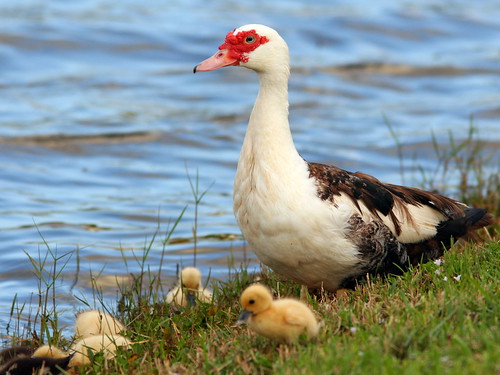
Only two of the ducklings were entirely yellow. They were destined to become pure white as adults:
Here she is now, with the surviving eleven babies, now well-feathered. Note that one of the white ducklings did not survive:
As our stay in northeastern Illinois drew to a close, we still hoped to see a few migrating birds that were not likely to appear back in Florida. The arrival of Fox Sparrows and juncos signaled the end of the passage of birds such as warblers and tanagers that fly through Illinois on their way to the neotropics. Now our hopes rose in anticipation of seeing some of the hardy birds from the far north that spend the winter there.
On our “wanted” list were Northern Shrike, Winter Wren, Nelson’s, LeConte, American Tree and Harris’s Sparrows, Snow Buntings, Lapland Longspurs, crossbills and Purple Finches. Trumpeter Swans and Whooping Cranes were also outside bets. All are birds whose migratory habits usually do not coincide with ours. Except for the Nelson’s Sparrow, we have seen all of them before. We saw the shrike, longspurs and Snow Buntings in Manitoba, but not yet in the lower 48 States. Normally, we have returned to Florida by this time of year, so we planned to take advantage of our delayed departure. Unfortunately, cold and windy weather kept us pretty much homebound during our final week, and Mary Lou developed a bad cold that dampened her desire to venture out into the field.
As I described in last week’s post, during a brief visit to Nelson Lake/Dick Young Kane County Forest Preserve I spotted a distant swan. It had a slight grayish tint to its plumage, indicative of an immature bird. The most common swan in the area is the introduced non-migratory Mute Swan. “If you hear hoof beats, think horses, not zebras” is generally good advice, so the challenge was to distinguish this swan from Tundra and Trumpeter Swans, both winter visitors from the north.Trumpeters nest not too far away, in northern Wisconsin, while Tundra Swans breed above the Arctic Circle.
This swan tended to hold its neck up rather straight, instead of in a gentle “S” curve that is typical of Mute Swans. The base of its neck did have a tight “S” curve close to its body that, from a distance, appeared to make its neck stick up from further back on the body. It also tended to keep its bill pointing relatively horizontal; Mute Swans’ bills often point more downward. Therefore, this swan was very likely one of our natives, either a Tundra or a Trumpeter Swan.
It was about a half mile away, and I did not have a spotting scope. My view through 10×42 binoculars was very similar to the highly cropped photos I obtained with my 420 mm lens system, which is equivalent to about 8x magnification. I again welcome any suggestions as to this bird’s identification, if possible with these images. Interestingly, only three days after I flew back to Florida, seven Trumpeter Swans (5 adults and 2 young) were identified by experts at this same location! Three out of the four people who commented on the photo believed it to be a Tundra Swan. I am re-posting the swan’s photo here just in case anyone missed it.
The base of the swan’s bill seemed pale, and the bill lacked the knob seen on adult Mute Swans (click on photo for more views):
A Northern Shrike had been seen a few days earlier at Prairie Green Wetlands in Geneva, Illinois, only a few miles away. The next morning I got out early and spent most of the morning looking for the shrike, but failed to find it. However, I encountered a small flock of American Tree Sparrows in the hedgerow along the entrance path, mixed in with White-crowned, White-throated and Savannah Sparrows.
Breeding in the treeless tundra, American Tree Sparrows do tend to spend more time in the treetops than other sparrows. which tend to disperse into low vegetation when disturbed. They were familiar winter birds during my early years in New Jersey, but they do not migrate down to the Southwest or the Deep South, where I have lived for over forty years.
A chestnut cap and a “stickpin” on its clear breast characterize the American Tree Sparrow:
The next day I set out to visit a nearby grassland in hopes of seeing longspurs. Just after I left the driveway I encountered a large flock of American Pipits wheeling over the road and the vacant lot in front of our condo. I pulled over, and some of the birds settled down right next to the car.
Unwisely, I had left my camera in the trunk and had to pull the trunk release. This frightened many birds, and they flew up and then settled down along the road a short distance ahead of me. After retrieving my camera, I used the car as a blind and slowly moved up closer.
American Pipit at close range (click on photo for more views):
One pipit flew up on a post. The blue line on its breast is not a normal feature. It may be a reflection from the paint:
For about five minutes I was treated to great views of the pipits. Parts of the the flock kept rising and returning to the ground– more appeared to be streaming in from the west. There were possibly 100 birds, and all were pipits– no Horned Larks or hoped-for longspurs and Snow Buntings. Then, the entire flock took off suddenly and flew low to the north, disappearing in a field across the highway.
I set out westward on a farm road (Seavey Road in Batavia) the next morning, determined to see Snow Buntings and longspurs. First looked for a reported the Ross’s Goose in the pond off Deerpath Road, but found only lots of Canada Geese and Mallards. Bad start! I continued past Bliss Road, and near the end of the pavement I began to see flocks of smaller birds in the corn stubble. Most were very difficult to view amid the stubble, but those I could identify were American Pipits and Horned Larks. Then, right on the road, two birds appeared in the same binocular view– a Lapland Longspur and a Snow Bunting!
I caught a Snow Bunting and a Lapland Longspur in the same frame– a poor image but a memorable moment:
A slightly better view of a Lapland Longspur…
…and a Snow Bunting:
Success! I eventually sorted out four or five Snow Buntings and two more longspurs. These were my first seen in the lower 48 states. None of my photos were very good, thanks to the harsh lighting conditions. I ended up seeing only four of my target species, but I am not complaining. The buntings and longspurs made a nice going-away present.
As may be evident from past blogs, I especially enjoy photographing the “little guys,” such as sparrows and warblers. During summer, there are very few species of smaller birds near our Florida home. Capturing images of small birds usually takes considerably more patience and stealth than is required for the herons and storks in Florida. Since the “little brown jobs” are usually hiding in shrubs and flitting about, their portraits are often marred by intervening vegetation, shadows and poor exposure. Here in northeastern Illinois, one bird obligingly came out into the sun for his portrait.
At Nearby Nelson Lake this past week, this Fox Sparrow sang quite loudly, despite the near-freezing temperature:
There are times when a flash would have greatly improved my photos, but so far I have not invested in tripods or flash attachments. Either would reduce the mobility I enjoy with my present 300 mm f/4 IS lens with a 1.4x extender, a combo that is relatively easy to hang around my neck or rest in a holster during long walks. However, I am tempted to get a flash unit. Even a bird in full sun may pose a challenge when it is overhead and seen against the sky.
For example, this Red-bellied Woodpecker’s underparts remain in deep shadow, for lack of a fill-flash:
Likewise, the back of this topsy-turvy little Black-capped Chickadee is under-exposed; luckily, its eye did catch the light:
Like so many sparrow shots, this earlier shot of a Fox Sparrow might have been perfect, except for those annoying little branches and the strong contrast caused by the late morning sunlight:
I was lucky to find this Red-tailed Hawk along the road, providing a side view with the sun coming in from the right; a flash might have added a “pop” factor:
Here is a close-up crop of its expressive face, which was in full sun:
A smaller and more colorful raptor, a male American Kestrel, stared at me from atop a streetlight this morning:
Warm low sunlight enhanced its colors as it stretched its wings and tail to display beautiful plumage. There is something extra nice about natural light:
Using the car as a blind, I rolled up closer to the Kestrel. Just as I pressed the shutter, it took off:
A lone swan showed up along the far shore of Nelson Lake, about a half-mile away. Without my 15-60x Kowa spotting scope, I could not distinguish any field marks that would nail down its ID. It was very light gray, suggesting it was an immature bird. It held its neck quite straight, not in an S-curve as do the more common Mute Swans. Tundra Swan is a possibility– note the light area at the base of its bill. I do not use a tripod, another trade-off, in addition to not using a flash attachment, that allows me greater mobility in the field. After lugging a scope and tripod for years, when we led bird walks, I tried it again on a three-mile hike in Florida and nearly died of heat exhaustion. As for the flash, I feel my resolve is weakening!
My hand-held photo, taken with a 420 mm lens system (300x with a 1.4x extender) is about equivalent to the view through 8x binoculars (click on image for more views– any ideas about its ID?):













